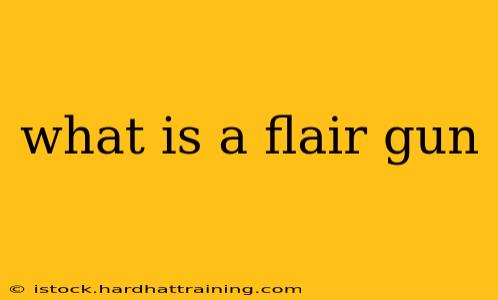Flare guns, often mistakenly referred to as flare pistols, are handheld devices designed to launch pyrotechnic flares. Unlike firearms that propel projectiles using gunpowder, flare guns utilize a smaller charge to eject a flare, a brightly colored or illuminating projectile designed for signaling or illumination. This distinction is crucial, as understanding the mechanics and purpose helps to avoid confusion and misuse.
How Does a Flare Gun Work?
The mechanism is relatively simple. A flare gun typically uses a self-contained cartridge containing a small propellant charge. This charge, upon ignition, forces the flare out of the barrel. The flares themselves are self-contained units, each containing its own pyrotechnic composition for producing light, smoke, or a combination of both. The process doesn't involve a complex firing pin mechanism like many firearms; the simplicity is part of what makes them relatively easy to operate (though safe operation still requires training and caution).
Types of Flare Guns and Flares
Flare guns come in various sizes and designs, each suited to specific purposes. The most common types are:
- Handheld Flare Guns: These are the most prevalent type, designed for ease of use and portability. They are frequently used for signaling purposes, particularly at sea or in emergency situations.
- Larger Caliber Flare Guns: These are less common and are often used in professional settings, such as maritime or aviation, for more powerful and longer-range flares.
The flares launched from these guns can also vary widely. They can be categorized by:
- Illumination Flares: These produce a bright light, ideal for signaling in darkness or low-light conditions. They are critical for nighttime search and rescue operations.
- Daylight Flares: These flares produce bright colors (often red or orange) and smoke, ideal for attracting attention in daylight conditions.
- Parachute Flares: These flares deploy a small parachute, extending their visible time in the air and increasing their range.
- Distress Flares: These flares specifically signal distress, typically emitting a bright red light and/or smoke.
Uses of Flare Guns
Flare guns are used in a variety of scenarios, primarily where signaling is crucial:
- Maritime Distress: At sea, flare guns are essential safety equipment, providing a visible signal to other vessels or rescue services.
- Aviation Distress: Though less common than maritime use, some aircraft carry flare guns for emergency signaling.
- Hunting/Wildlife Management: In certain contexts (and where legal), flare guns can be used for signaling or deterring wildlife.
- Search and Rescue Operations: In emergency situations onshore, flare guns can signal location to rescuers.
- Military and Law Enforcement: Although not as common a primary tool, they can have specialized applications within these fields.
Safety Precautions
Crucially, flare guns are not toys and should be treated with extreme caution. Improper handling can lead to severe injury. Always adhere to the following safety guidelines:
- Training: Proper training in the safe handling and operation of flare guns is essential before using them.
- Legality: Check local laws and regulations regarding the ownership and use of flare guns before purchasing or using them. Possession and use might be restricted in some areas.
- Storage: Flare guns and flares should be stored in a cool, dry, and secure location, away from children and unauthorized individuals.
- Handling: Never point a flare gun at yourself or others. Always treat it as if it were loaded.
This guide provides a comprehensive overview of what a flare gun is and its various applications. Remember to prioritize safety and legality when considering their use. If you have any doubts or need further information, consult with relevant authorities or professionals.
